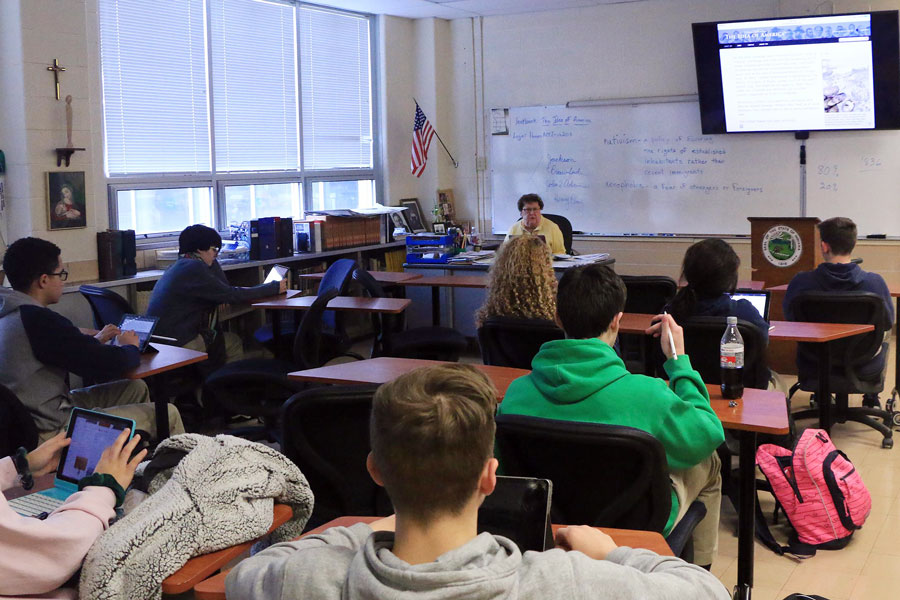Pandemic: Teacher provides historical perspective
Sr. Stewart notes similarities between today, Spanish flu in 1918
Sr. Mary Ann Stewart, at her desk in her classroom in Kelly Hall, provided her thoughts about the current coronavirus pandemic and its historical significance.
The current COVID-19 pandemic has created numerous references to the 1918 Spanish flu outbreak. Sr. Mary Ann Stewart, who teaches ACP United States History, provides her perspective on both current and historical events.
According to the Centers for Disease Control and Prevention, commonly known as the CDC, “the 1918 influenza pandemic was the most severe pandemic in recent history.”
H1N1 virus, the origin of the flu, spread worldwide in 1918 and 1919. First identified in military personnel, the disease infected roughly one-third of the world’s population, and took at least 50 million lives worldwide. There were 675,000 deaths in the United States alone at time that the population of the country is about one-third of what it is now.
A high mortality rate in healthy 20- to 40-year-olds made the disease especially frightening.
“With no vaccine to protect against influenza infection and no antibiotics, control efforts worldwide were limited to non-pharmaceutical interventions such as isolation, quarantine, good personal hygiene, use of disinfectants and limitations of public gatherings, which were applied unevenly,” according to the CDC.
Echoes of this disease can be seen today as the coronavirus, or COVID-19, sweeps the nation. All over the world, nations are mandating self-quarantine for their citizens in an effort to reduce the effect of the contagious disease.
In times like these it can be helpful to look at the past in order to better understand potential events to come.
Sr. Stewart shared her insight into the flu pandemic of 1918 through the Saint Mary-of-the-Woods archives.
Word of the disease was received at Saint Mary-of-the-Woods College in September, 1918. Boston was greatly suffering from its effects.
According to Sr. Stewart, “In October, the sisters were continuing to pray for an end to the flu” as well as for the lives of the many young soldiers still fighting in World War I, as the nuns were aware that may of these soldiers had contacted the flu and were dying of the disease. Many cases of illness appeared to be pneumonia but later were identified to be the flu.
Saint Mary-of-the-Woods suffered with the rest of the world but to a much lesser degree, not experiencing serious cases.
All across the nation celebrations and gatherings were closed or canceled, “even Liberty Day,” added Stewart. Likewise, similar to today, the State Department of Health ordered schools and other places of assembly to close.
Due to the restrictions on gathering, no visitors were allowed at the school, and under strict observance, a limited number of believers could attend at Masses in the church. Even funerals were prohibited, and seven sisters of Saint Mary-of-the-Woods were taken directly to the cemetery for prayers before they were buried.
As for classes, many took place outside on the campus grounds in hopes to quell the spread of the virus and to allow for fresh air. According to Sr. Stewart, the students were glad to be outside and away from “the sickening odor of eucalyptus oil in every nook and corner of the campus.” Eucalyptus was believed to purify the air, she said.
As for Stewart’s own family, though her parents and grandparents were living in Indiana, no mention was ever made of anyone in the family dying from the flu. Sr. Stewart noted that once people experienced the tragedy of the flu pandemic, they often chose not to talk about it.
She also noted that the 1918 epidemic is often overlooked in the high school social studies curriculum. Sr. Stewart said, “There is very little mention, if any, of the Spanish flu in U.S. History textbooks. (Book) editors have to pick and choose what to include. Most textbooks move immediately from a discussion of the Treaty of Versailles at the end of World War I to focus on the culture of the 1920s: women’s rights, the rebirth of the Ku Klux Klan and then the stock market crash and the Great Depression.”

Katie Darragh is a senior and a reporter for newspaper. She is a co-captain of the speech and debate team, and is also a thespian who is very active in...







